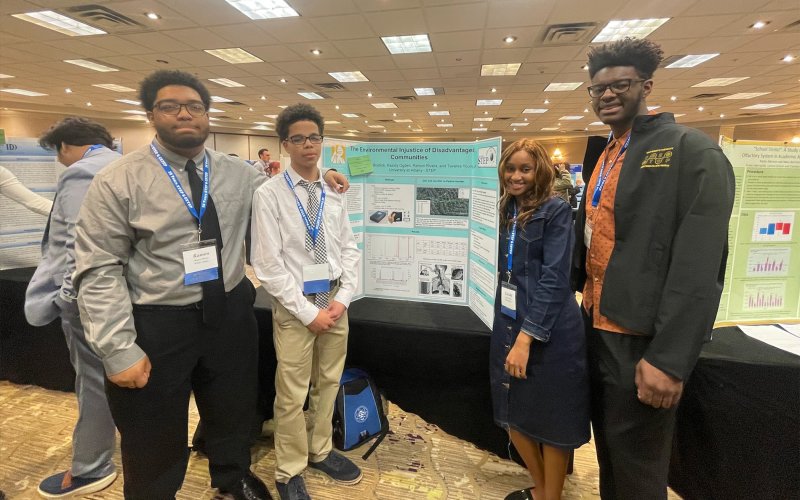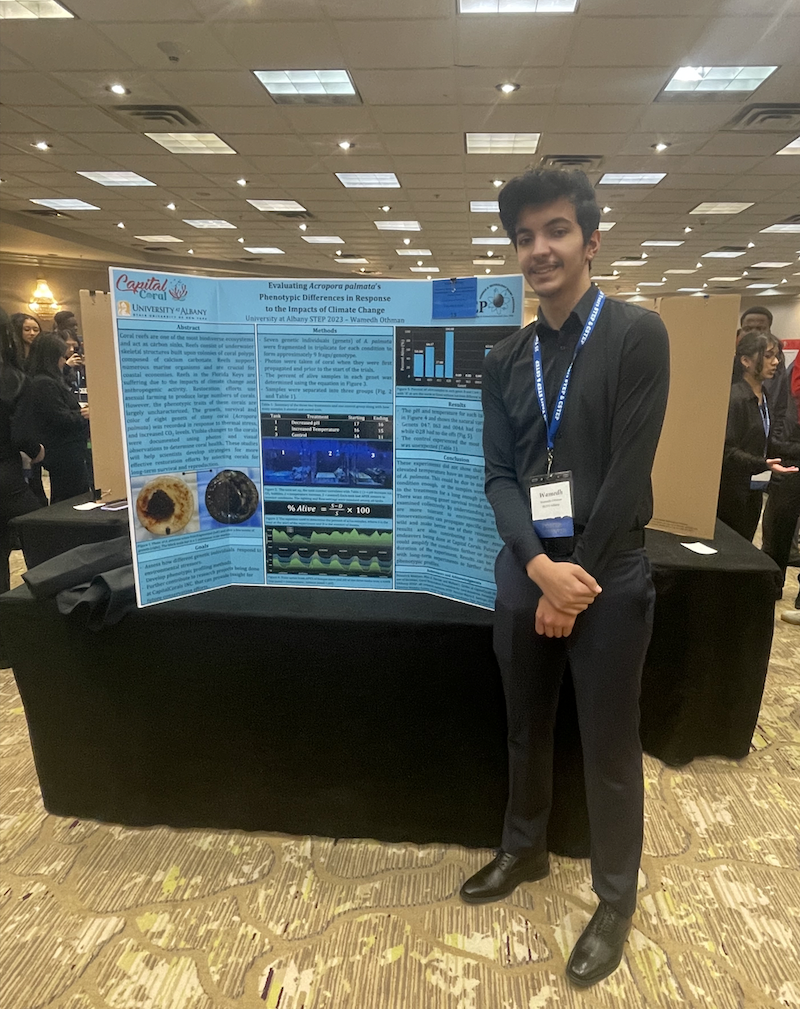UAlbany Team Wins First Place at Statewide Science, Technology Conference

By Bethany Bump
ALBANY, N.Y. (April 4, 2023) — Last summer, a handful of students from Capital Region high schools teamed up with scientists from the state Department of Environmental Conservation to measure levels of air pollution throughout the city of Albany.
Equipped with devices that calculate lung deposited surface area (LDSA) — a measurement of particulate matter in the air correlated with adverse health effects — the students walked along Second Avenue through the city’s South End neighborhood on through to Whitehall Road, taking measurements as they went.
Their recordings revealed higher levels of pollution in the city’s disadvantaged communities, defined as those housing larger numbers of people of color and residents of lower socioeconomic status. These neighborhoods were more likely to have traffic, bus stops, construction and other pollution-generating features than non-disadvantaged communities, the students noted.
“I was able to walk around my own community and see the actual effects of the research that we had been doing,” said Ramon Rivera, a 12th grader at Green Tech High Charter School, who participated in the research through the University at Albany’s Science & Technology Entry Program (STEP). “It was eye opening.”
Rivera and his teammates on the project won first place in their category after presenting their research at the 23rd annual STEP Statewide Student Conference, held March 24-26 at the Marriott Hotel in Colonie. The conference was an opportunity for students participating in STEP programs around the state to gather and present research they have been working on, attend college fairs and workshops on financial aid, among other activities.
UAlbany is home to one of the state’s inaugural STEP programs, which seek to prepare historically underrepresented and economically disadvantaged middle and high school students for college and careers in science, technology, engineering and math (STEM) fields and licensed professions. For 37 years, UAlbany has provided academic enrichment, internship and mentoring opportunities through this program to students from schools across the Capital Region.
“The degree of resilience, hustle and hard work I have witnessed in our STEP students coming out of the pandemic is unparalleled,” said Mayra Santiago, director of UAlbany’s Office of Access and Academic Enrichment, who oversees the STEP program. “They demonstrated a level of perseverance I am confident will carry them through their journey in college and beyond.”
Nearly four dozen teams presented research at the conference earlier this month. UAlbany’s STEP program had two teams present.
In addition to Rivera, the air pollution research was conducted by Uriyah Bostick (12th grade, South Colonie High School); Kazidy Ogden (12th grade, Loudonville Christian High School); and Tavares Young, Jr. (12th grade, South Colonie High School).
Young, who plans to attend UAlbany when he graduates, explained how higher levels of fine particulate matter are linked to worse health outcomes for communities because of the particle size.
“The smaller the particle is the easier that particle can get into things like your bloodstream and your lungs,” he said. “And that can lead to other really bad things like increased cases of asthma or even heart disease.”
Students involved in the project said they were grateful for the STEP program for the educational opportunities it provided. The research itself was interesting, they said, because it was hands on and felt so impactful to everyday life.
“I know for me, when I first started doing this research I didn’t really realize it was such a big deal, and how it was impacting people in disadvantaged and non-disadvantaged communities,” said Ogden. “But actually going out and measuring data, putting our data together and actually reviewing what we got — my understanding opened up and I was able to educate myself."

A separate research project on the impact of climate change on coral reef habitats was conducted by Wamedh Othman, an 11th grader from Albany High School, who is also enrolled in UAlbany’s STEP program. His project earned an honorable mention at the conference.
Othman worked with CapitalCorals, Inc., to simulate and observe different environments for an endangered form of coral called Acropora palmata.
“I've been in this program since middle school and over the years it’s opened up different opportunities for me that helped me choose a career that I want to pursue,” said Othman, who said he wants to be a doctor or work in the biology field.
Last summer, UAlbany was able to expand the number of students it enrolls in STEP thanks to a $50,000 donation from Bank of America. Each year, the University serves approximately 300 students through summer and academic year programming.
“Due to our collaborations with NYSED, BOA, DEC and Capital Corals and the commitment to the youth that we serve in the Capital Region, we can have a successful STEP program,” Santiago said.




